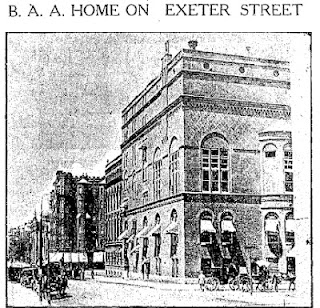No matter what his or her specific goals, every runner who lines up in Hopkinton next Monday will be hoping to do the same thing--cross the finish line on Boylston Street. Although the painted line midway between Exeter and Dartmouth streets has an air of permanence, the finish has changed several times during the races 116-year history.
For the first running of the Boston Marathon back in 1897, BAA officials wanted their 24.5 mile course to mimic the Olympic marathon which had finished in a stadium. The closest thing Boston had to offer was the Irving Oval, a 220-yd track near Copley Square.
 |
| The second site of the finish line |
The BAA was not untouched by the Great Depression and in 1936 it was forced to sell its clubhouse to Boston University, which renamed it the Soden Building. It continued to serve as race headquarters and site of the finish line until it was razed in 1959. At that point, the BAA moved its race-day operations across the street to the Lenox Hotel allowing the finish to remain on Exeter Street.
When Prudential Insurance stepped in as title sponsor in 1965, the tape was moved for the first time in years so that runners could finish in front of the newly-completed Prudential Tower. After 20 years, however, the marathon got a new sponsor and a new finish. In 1985, John Hancock signed on as the new title sponsor and so the 1986 finish was moved down the block to it's present day location.
While today's finish line might not be the same one that made Amby Burfoot, Bill Rodgers, and Alberto Salazar famous, it's much closer to the historic one cross by Clarence DeMar, John Kelley (both of them), and other historic victors from the event's first half-century. Maybe I can channel some of their energy next Monday!
________________
Today's Run: 7.3 miles at 7:57 pace.
No comments:
Post a Comment